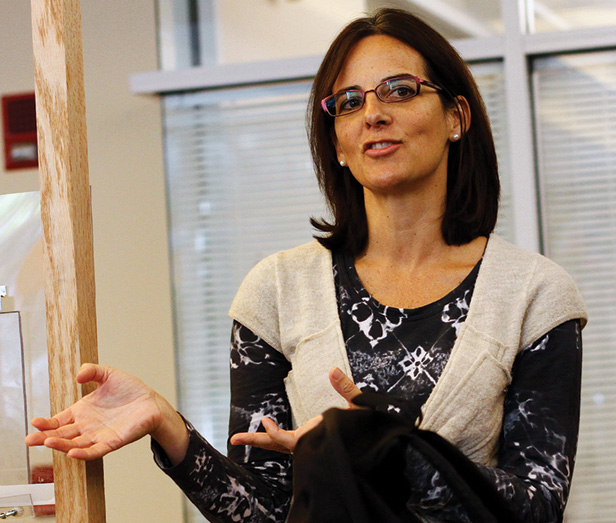Wild Types, Ferrofluids, and Robots

I’m meeting with Hisham, a junior mechanical-engineering major working on a flexible joint for a snake-like robot. My job is to help him with the paper he’s writing about it. The robot, he tells me, will be used in municipal water pipes to monitor pipe stability and check for cracks, corrosion, and other problems; it will operate autonomously, in water, and in a complex network of pathways. That means the joint must be robust, waterproof, and bendable. I get that. But I admit that I’m baffled by something called the transfer function in the algorithm that determines the joint’s behavior.
Unexpectedly, Hisham asks: “Is your job as a communications instructor especially challenging because you’re not a scientist?”
Ah, the million-dollar question.
As one of more than 30 lecturers in MIT’s Writing Across the Curriculum program, I work with undergraduates as they write papers and create presentations for their science and engineering classes. I serve as instructor, giving lectures and leading discussions on communication principles and strategies, and coach, working closely with students as they develop their abilities to effectively share ideas, research, and designs.
While Hisham is right to wonder whether comprehending all the science that goes on at MIT can be challenging for a humanities person, that challenge is also a source of intellectual adventure. Every day, I learn not only from the technical lectures and labs I attend in the classes I work with but also from students, who are typically generous and enthusiastic about explaining their research.
From one team of students in 10.26/27/29, the chemical-engineering projects lab, I came to understand the pathology of Alzheimer’s disease; from another team, the metabolism of Jurkat leukemia. Will, a student in 2.671, the mechanical-engineering measurement and instrumentation course, introduced me to ferrofluids, magnetic nanoparticle suspensions that deform in a magnetic field. When he presented his research at a poster session, he brought a sample in a beaker. I couldn’t resist touching the delicate corrugated bump that rose from the surface of the fluid when a magnet was applied to the underside of the beaker. A stain lingered on the tip of my finger for days.
I encountered the term “wild type” in my first semester as an instructor at MIT, in 7.02 (Introduction to Experimental Biology and Communication). To my mind, it seemed a great name for a dance. Not afraid to admit to what I don’t know, I asked the class of 15 students, “What’s the wild type?” They looked hesitantly around the table at each other, as though to signal Is she for real? Finally one student responded, “It’s the state of the organism as it exists in nature. Not mutated in the lab.” Her answer made me laugh out loud at my own naïveté, and the students laughed too. By now, I can list the procedures for an experiment on Pfu DNA polymerase almost by heart, but when I see the term “wild type” in a report, I still picture a single cell shimmying to music only it senses.
Even though I’m learning as I go, I help students become better communicators by thinking of myself as a proxy for the intended audience. I stand in for technical faculty (who will ultimately review the students’ work), scientific journal editors, professional mentors, and even the general public—whomever the students imagine reaching with their reports and talks.
Of course, I teach overtly, too. One chemical-engineering senior had trouble understanding and synthesizing in his writing some journal articles about computational models for investigating biological systems. Although I couldn’t write on that topic, I could still incrementally lead him to new insight without offering “the answer.” By framing questions, tracing logic (or obstacles to it) through a draft, identifying textual sources of confusion, and seeing the relationship between details and the whole, I am able to guide students into becoming the authority on—and ultimately the teacher of—their own work.
On my best days I feel like a midwife, helping to bring knowledge into the world. To answer Hisham’s question, I tell him that I persistently try to understand complex technologies, with the help of students. By drawing a diagram and explaining the transfer function, for example, he teaches me about the robot’s movement.
This work of teaching communications at MIT is ultimately a collaboration—a dance of sorts—in which teacher becomes learner, and learner becomes teacher.
Jane Kokernak has been an instructor in MIT’s Writing Across the Curriculum program since 2008.
Keep Reading
Most Popular
Large language models can do jaw-dropping things. But nobody knows exactly why.
And that's a problem. Figuring it out is one of the biggest scientific puzzles of our time and a crucial step towards controlling more powerful future models.
The problem with plug-in hybrids? Their drivers.
Plug-in hybrids are often sold as a transition to EVs, but new data from Europe shows we’re still underestimating the emissions they produce.
Google DeepMind’s new generative model makes Super Mario–like games from scratch
Genie learns how to control games by watching hours and hours of video. It could help train next-gen robots too.
How scientists traced a mysterious covid case back to six toilets
When wastewater surveillance turns into a hunt for a single infected individual, the ethics get tricky.
Stay connected
Get the latest updates from
MIT Technology Review
Discover special offers, top stories, upcoming events, and more.